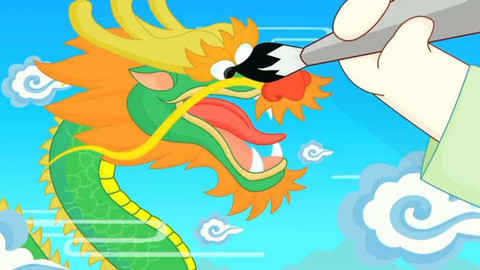链接复制成功!现在分享给好友吧。
Everything we touch and create needs a critical aspect. It requires something crucial to portray its fullness; to conceive the magic. It does not have to be resplendent like elaborate works of art. It can be as simple as cooking a dish, where one needs to put the finishing seasoning as the vital finishing touch of the viand; perfecting it. It can also mean adding the final edit of a picture or writing the ending of fan fiction. It can be innocuous but still vital. We, as the creators, need to put the final finishing touch to the masterwork. We need to add a vital element to make it complete. Like the Chinese idiom dotting in the eyeball when painting a dragon.
Today is yet another day to examine a philosophical Chinese idiom 画龙点睛 (huà lóng diǎn jīng) directly translates into “dotting the eyeball when painting a dragon.” The idiom means adding a crucial part to something, making it complete. It’s applying the finishing touch, akin to bringing artwork to life.

Chinese idiom is a part of the long history of China. Most of the idiomatic expressions used today endured from antiquity. One generation passed the idiom to another, eventually reaching the modern world. One of those idioms is 画龙点睛 (huà lóng diǎn jīng).
The idiom originated from one Chinese legend.
In ancient times, there was an artist who mastered realism. He is one of the best painters in ancient China. He specializes in incredible life-like paintings. One day, he painted dragons on the walls of one temple. The dragons were painted so vivid and looked like real ones. The paint is perfect. However, onlookers can’t help but notice that the painter missed one crucial aspect. The dragons don’t have eyeballs. People confronted the artist for his reason for not painting the eyeballs.
He retorted that the dragons would fly away once being painted eyeballs. Even in ancient China, where magic and miracles were prevalent, people still didn’t believe him. People thought he was lying. They convinced the artist to draw the eyes and complete the painting. The artist reluctantly painted the eyes. With four dabs of ink, the eyes are complete. Suddenly, lightning struck, hitting the painting. Seconds after, two giant dragons rose into the sky, flying away.
With the origin down, let us now examine the knowledge point of this idiom.
画龙点睛 (Huàlóngdiǎnjīng)
画 (Huà) Fourth tone, means draw.
龙 (Lóng) Second tone, means dragon.
点 (Diǎn) Third tone, means point, dot, spot.
睛 (Jīng) First tone, means eyeball. It’s often paired with “眼 (yǎn) eyes,” the words “眼睛 (yǎnjīng)” means “eyes”.
Now that we have examined the knowledge point, we must look at which contexts are we allowed to use this idiom. The central point of the idiom revolves around “putting a finishing touch.” You can use it in a context that allows that point to go across.
Example 1:
Zài jiēdào jiànshè zhōng yào huàlóngdiǎnjīng de shèzhì rú zuòyǐ, huātán
在 街道 建设 中 要 画龙点睛 的 设置 如 座椅、花坛。
An establishment like chairs and flower-bed must add the finishing touch to the street construction.
Example 2
Zhè děngyú gěi yì fú xiànshí túhuà zuìhòu lái yí gè huàlóngdiǎnjīng
这 等于 给 一 幅现实 图画 最后 来 一个画龙点睛。
It had put the finishing touch of reality.
It is imperative to remember that the idiom’s usage revolves around “adding a crucial point.” It involves adding a vital finishing touch and perfecting the work. One can use the idiomatic expression in contexts that align with the central premise. Its usage can apply to a work of art, literature, and even architecture.
As long as someone is adding a significant element to a work, making the creation more vivid and powerful, it is applicable. Furthermore, the idiom can also apply in contexts where someone needs to put a crucial point in the composition. Thus perfecting the creation of “bringing it to life.”
Remember, 画龙点睛 (huà lóng diǎn jīng) does not only apply to grandiose works of art. We can also use it in the simple things of everyday life. It can apply in cooking, cleaning, and maintaining, as long as you’re introducing a crucial touch to something, it’s 画龙点睛 (huà lóng diǎn jīng).
Till our next Chinese idiom, take care!
Your first 1-on-1 Chinese lesson offer